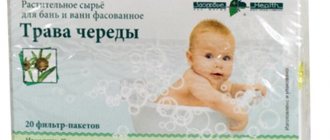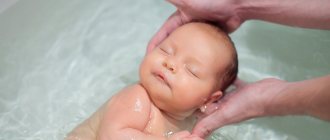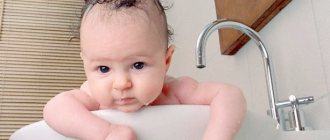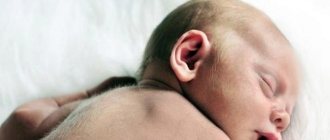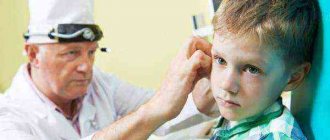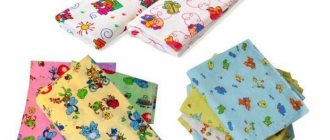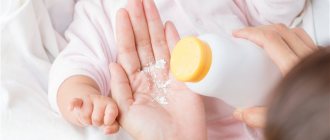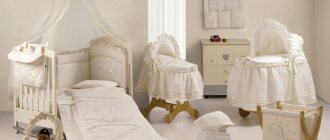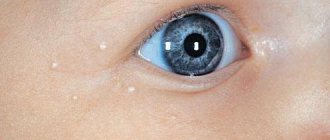Why do you need to swim in such water?
Tap H2O contains large amounts of:
- microorganisms,
- minerals,
- microelements,
- salts,
- acids,
- alkalis,
- grounds.
The baby's delicate skin and mucous membranes are not accustomed to these substances, so a negative reaction may develop.
In addition to using boiled water, bathing must be done according to the rules so that the baby does not choke in the water or get injured. It is important not to use detergents in the first months, as an allergic reaction, irritation, and dermatitis may occur.
Advantages and disadvantages
The following positive aspects are noted:
absence of negative reactions of the skin and mucous membranes, since chemical and organic compounds are destroyed or decomposed;- gradual adaptation to the microflora, colonization of the external parts of the urinary organs, skin, mucous membranes by opportunistic bacteria;
- cleansing skin surfaces from particles of sebum and sweat;
- reducing the risk of developing heat rash.
This method has negative sides:
- prolonged heating of water, inconvenient for parents;
- lack of penetration of beneficial microelements and minerals onto the surface parts of the baby’s body, which have a positive effect on his body (calcium, potassium, magnesium);
- If the boiling water cools down for a long time, parents may not notice that the water is too hot for the baby’s sensitive skin.
To eliminate the risk of negative effects when using boiled water, consult an experienced pediatrician before the birth of the child. He will tell you how to bathe him correctly, what beneficial substances to add to the water.
Is it necessary to do this?
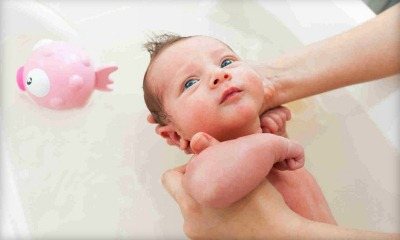
Pediatricians believe that bathing in boiled water is an unnecessary, outdated method.
The state installs high-quality water filtration and purification devices that eliminate most of:
- pathogenic microorganisms,
- bacteria, bacteria
- mushrooms,
- chemicals.
They penetrate there in minute doses or are completely absent. If the region considers the water clean and adults can drink it even from the tap, without using additional filtration or boiling methods, then its use for infants will not cause negative reactions.
Some regions are identified where tap water is considered contaminated. If the concentration of chemicals, chlorine, bacteria, fungi in it is too high, be sure to use boiled water for bathing. This will protect the child and prevent the risk of developing candidiasis, vaginitis, and allergic reactions.
First bath of a newborn: where to start
Bathing for a newborn is not only and not so much a way to become clean, because such a baby simply cannot be heavily soiled. This is, first of all, a pleasant, soothing procedure that reminds the baby of the glorious days in the womb, where the child was in an aquatic environment for nine months. He feels comfortable in the water; bathing has a positive effect on the physical and emotional development of the baby.
The first and most important thing you can’t do without when bathing your baby is a bath. Sometimes parents prefer to immediately accustom their newborn to an adult bath, but at least for the first couple of months it is better to use a small baby bath. Firstly, it is safe and hygienic. Secondly, the baby will be more comfortable in a small bathtub than in a large space. Don’t forget that he lived for a long time in his mother’s cramped tummy and the space still scares him. Thirdly, it will be more convenient to fill a small bathtub with warm water, even if the hot water supply is turned off.
The bathtub must first be washed with regular baby soap: you should not use various “adult” cleaning products. Then you need to fill it with warm water: 35-37 degrees. The water should be comfortable, not hot.
If a child becomes flushed while swimming, it means that the water temperature was too high, and this can have a bad effect on the baby’s well-being and mood. To measure temperature, if you don’t have a special thermometer at hand, use the “elbow method”: determine by touch how comfortable the water is.
Do I need to boil water and add potassium permanganate to it?
Just a few decades ago, the correct answer to these questions was clear: yes. Modern pediatricians are more loyal: it is not at all necessary to boil water. This is only appropriate for bathing children whose umbilical cord has not yet fallen off. By the way, doctors previously advised to wait until the navel falls off and only then wash the baby. Today, opinions on this issue vary: some experts advise waiting until the navel falls off, others argue that there is nothing wrong with bathing a newborn with an unhealed umbilical wound.
Adding potassium permanganate to water is also considered a relic of the past: the product greatly dries out the delicate skin of children, and an excessive concentration of the solution can even cause a burn.
As for all kinds of means for bathing children: it is quite possible to do without gels and foams, especially in the first months of a baby’s life. Many parents rush to fill the house with dozens of bottles and tubes with the inscriptions “no tears” and “0+”, but at first it is enough to wash the baby with regular baby soap 1-2 times a week. The rest of the time, bathe in plain tap water. Later, of course, you can buy aromatic foaming products: with the right approach to purchase and careful study of the composition, they will not cause harm.
Some pediatricians advise bathing a newborn in a decoction of herbs - valerian, motherwort and chamomile - so that the child sleeps better and is calmer. You need to be careful with seemingly harmless herbs: they can cause an allergic reaction, especially in very young children who are not even a month old. If allergies do not manifest themselves, sometimes you can practice bathing in herbs. Most likely, there will be no magical effect from valerian or string, but it will not cause harm either. But, in any case, this issue should be discussed with the baby’s attending physician.
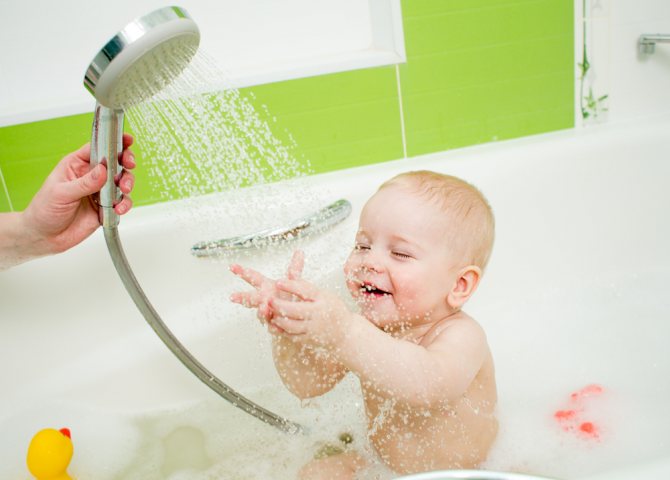
Until what age?
Active colonization of skin surfaces and mucous membranes by opportunistic microflora occurs within 1-3 months from the beginning of birth. To use regular tap water, you don't have to wait that long.
During the first month of life, the baby already gets used to all the microorganisms with which he comes into contact.
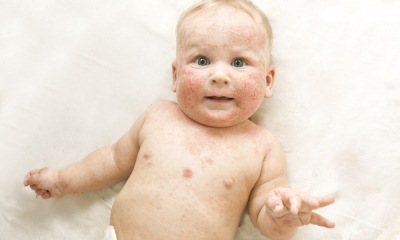
The exception is children who have the following diseases:
- dermatitis, dermatosis, seborrhea;
- allergic reactions on superficial tissues, accompanied by rash, itching, burning, redness, inflammation, swelling;
- abundant wounds, erosions, ulcers.
Then they initially undergo laboratory and instrumental examination methods and undergo treatment.
If no contraindications are identified after therapy, the pediatrician will give permission to bathe in tap water. He may recommend adding various drugs to it for treatment .
What water should I bathe my child in?
The first thing you need to pay attention to is the baby's bathroom. In a special baby bath it is easier to simply wash the baby, and in a large bath it is convenient to do water gymnastics with him. There are also specially designed swimming rings that support the baby under the neck. Together with him, the baby will be able to move in the water on his own.
The bathtub will need to be filled with water. Children's doctors advise bathing your baby in regular tap water. It is clean enough and suitable for a newborn. And to disinfect the umbilical wound, you can make a weak solution of sea salt.
Everyone should know this! Babies are bathed in water with a temperature of 37 degrees.
Many people believe that bathing in herbal infusions brings great benefits to a newborn. This is, of course, true, but there is no need to overdo it. For such a baby, even a decoction is a potent medicine, so before using them, consult your doctor.
Each herb has a different effect on baby's skin:
- Chamomile relieves dryness
- The sequence helps with diaper rash
- Bay leaf - for diathesis
Which is correct?
Bathing must follow all the rules to avoid negative reactions. Be sure to select the following parameters so that the baby does not become frightened and comfortable and safe conditions are created:
- Temperature regime . Pharmacies sell special thermometers for measuring baby's bathing water. The indicator can vary between 34-37 degrees. If it is lower, hypothermia is possible. High temperatures will lead to irritation and unpleasant sensations in the body. The baby will start crying.
- Volume. Pour in such an amount of water that only the baby’s body, without the head, is immersed in it. Parents should be nearby at all times to prevent accidental full-body immersion resulting in choking. This can happen with constant movements that the baby makes.
To bathe a baby, do not use a shared bath. Even with daily disinfection, particles, substances, and hair left behind by adults remain in it.
Buy separate baths, which are treated with hypoallergenic detergents before each use. Special nets and plastic recesses are sold that make it easier to place a baby for bathing. They will protect you from slipping and accidental diving.
What substances and components can and cannot be added?
Various components are added to water that have a disinfecting and anti-inflammatory effect.
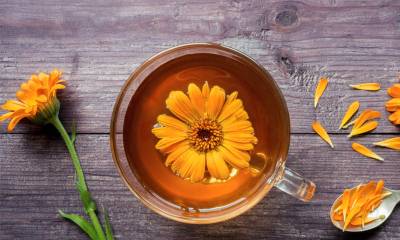
Pediatricians recommend the following products for use:
- decoctions of plants (calendula, string, chamomile, bay leaf);
- emolium (a drug that eliminates allergic reactions, irritation, dry skin).
Cosmetics are added when the child gets older (at 3-6 months). They have cleansing properties. Read the composition to ensure it does not contain chemicals or carcinogens.
Potassium permangantsovka
Manganese is a chemical component that has antiseptic properties . Previously, it was used to bathe infants to disinfect water from pathogenic microorganisms.
At the moment, pediatricians have abandoned it, as it has many side effects. If too much manganese is added, the baby will develop a burn on the skin that spreads throughout the body.
With constant bathing in potassium permanganate, the skin becomes dry and begins to peel. Then the formation of dermatitis and allergic reactions is possible.
Baking soda
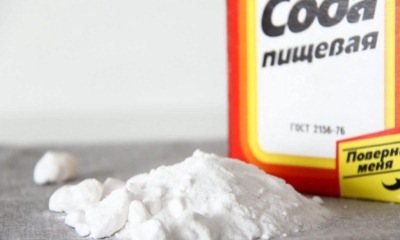
It becomes dry even with one bath. If there are skin lesions or microcracks, itching and burning occur.
Side effects persist even if you dilute the soda repeatedly . Instead, products with moisturizing properties are used. Herbal decoctions are suitable. They effectively remove harmful components from the liquid, but have a beneficial effect on the skin.
Herbal decoctions for bathing
A baby's skin is especially sensitive in the first days after birth, so you can add decoctions of some herbs to the bath: chamomile, string or sage. They not only have a beneficial effect on the skin, but also allow the child to relax and fall asleep after bathing. For this:
- add 4-5 large spoons of dry grass to a container with one liter of boiled liquid;
- then the broth needs to brew until the blades of grass settle to the bottom;
- the resulting infusion must be filtered through gauze or a strainer;
- then it is added to the bath.
It is not necessary to add the infusion to the bath, but it can give additional strength to the baby’s body. However, you should closely monitor your child to prevent allergic reactions.
Every parent can answer the question of whether to boil water for bathing a newborn only after watching their baby. After all, each child’s umbilical wound heals differently, and allergic reactions can occur even in the first days after birth.
How long in time?
Pediatricians do not set a strict time during which a baby should be bathed. The bath is taken as long as the child remains in a good mood and likes the water. If this time is extended excessively, it may cool down and the temperature will drop below 34 degrees.
If the water cools down, do not add hot water, otherwise a burn will occur.
It is allowed to use warm liquid that has cooled to 36-37 degrees . Newborns usually cannot handle bathing for more than 30 minutes. As soon as the baby stops enjoying being in the bath, the procedure is stopped.
Preparing for a swim
In order for the bathing procedure to be successful, prepare everything you need in advance (I will say more about this below). It would be nice to call someone older for help (a grandmother, for example, or even an experienced neighbor). It would be wonderful if the father took part in all matters from the first day, including helping to bathe the baby - after all, from the very first days, the child needs to feel the love and care of both parents, and the father, holding a tiny creature in his arms, gets all this will help you feel more courageous and responsible. In addition, it has been established that the earlier the father begins to take part in all activities related to the care and upbringing of the child, the stronger the relationship between them becomes in the future.
So, before you start swimming, prepare everything you need in advance.
Firstly, water.
The fact is that the child is bathed only in boiled water until the umbilical wound heals (this usually happens at the age of 18-22 days), so the water must be boiled in advance so that it gradually cools down to 38°C.
Secondly, the premises
where you will bathe must meet several requirements: be warm (air temperature 22-24°C), free from drafts, and be comfortable so that you can approach the bath from all sides. Many people bathe in the bathroom, placing the baby bath on a stand, but, in my opinion, it’s more convenient to do this in the kitchen, where you can heat the air well, put the bath on the dining table (and then you won’t have to bend over to hold the baby), and , besides, the kitchen is usually much lighter.
Thirdly, you should prepare your clothes in advance
, in which you will dress the child after bathing, usually these are: 2 diapers (thin and thick), 2 vests (thin and thick), a diaper, a cap. All this must be laid out on the changing table in advance in the order in which you will need it.
In addition, you also need a 1.5-2 liter jug for pouring, a soft towel, baby soap, cotton wool, boiled vegetable or petroleum jelly, powder; brilliant green and a 3% solution of hydrogen peroxide to treat the umbilical wound, and finally, prepare a highly concentrated solution of potassium permanganate in a small bottle (you will drop a few drops into the bathing water until the umbilical wound heals), 2 pipettes.
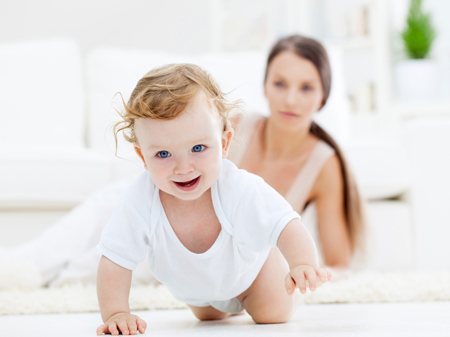
There is an alternative!
Not all doctors are inclined to use boiled water for bathing newborns. They believe that these measures are too strict and unnecessary.
Parents can use other types of H2O:
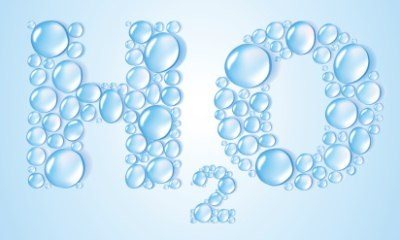
From the tap, if it is clean enough for the region.- Distilled - in it, various types of chemicals and microorganisms are destroyed using a distillation device that operates on the basis of evaporation.
- Filtered by home appliances built into the plumbing system.
If adverse reactions occur after bathing procedures, it is not recommended to independently add various types of drugs and antiseptic substances to the bathing water. They contact a pediatrician who will identify and eliminate the causes after examination and testing.
